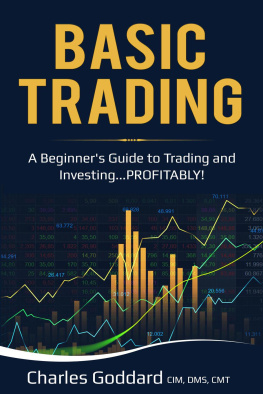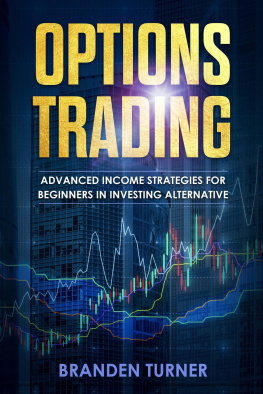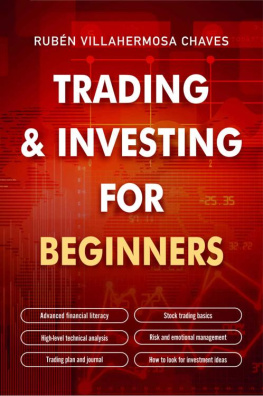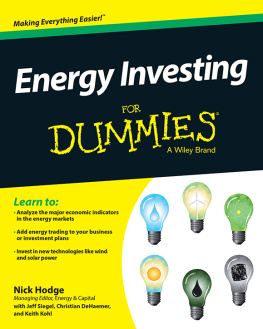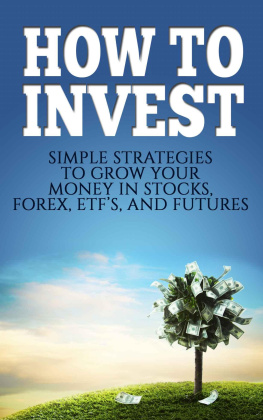Davis W. Edwards - Energy Trading and Investing
Here you can read online Davis W. Edwards - Energy Trading and Investing full text of the book (entire story) in english for free. Download pdf and epub, get meaning, cover and reviews about this ebook. year: 2017, publisher: McGraw-Hill Education, genre: Romance novel. Description of the work, (preface) as well as reviews are available. Best literature library LitArk.com created for fans of good reading and offers a wide selection of genres:
Romance novel
Science fiction
Adventure
Detective
Science
History
Home and family
Prose
Art
Politics
Computer
Non-fiction
Religion
Business
Children
Humor
Choose a favorite category and find really read worthwhile books. Enjoy immersion in the world of imagination, feel the emotions of the characters or learn something new for yourself, make an fascinating discovery.

- Book:Energy Trading and Investing
- Author:
- Publisher:McGraw-Hill Education
- Genre:
- Year:2017
- Rating:4 / 5
- Favourites:Add to favourites
- Your mark:
- 80
- 1
- 2
- 3
- 4
- 5
Energy Trading and Investing: summary, description and annotation
We offer to read an annotation, description, summary or preface (depends on what the author of the book "Energy Trading and Investing" wrote himself). If you haven't found the necessary information about the book — write in the comments, we will try to find it.
Energy Trading and Investing — read online for free the complete book (whole text) full work
Below is the text of the book, divided by pages. System saving the place of the last page read, allows you to conveniently read the book "Energy Trading and Investing" online for free, without having to search again every time where you left off. Put a bookmark, and you can go to the page where you finished reading at any time.
Font size:
Interval:
Bookmark:

Copyright 2017 by McGraw-Hill Education. All rights reserved. Except as permitted under the United States Copyright Act of 1976, no part of this publication may be reproduced or distributed in any form or by any means, or stored in a database or retrieval system, without the prior written permission of the publisher.
ISBN: 978-1-25-983539-1
MHID: 1-25-983539-1.
The material in this eBook also appears in the print version of this title: ISBN: 978-1-25-983538-4, MHID: 1-25-983538-3.
eBook conversion by codeMantra
Version 1.0
All trademarks are trademarks of their respective owners. Rather than put a trademark symbol after every occurrence of a trademarked name, we use names in an editorial fashion only, and to the benefit of the trademark owner, with no intention of infringement of the trademark. Where such designations appear in this book, they have been printed with initial caps.
McGraw-Hill Education eBooks are available at special quantity discounts to use as premiums and sales promotions or for use in corporate training programs. To contact a representative, please visit the Contact Us page at www.mhprofessional.com.
This publication is designed to provide accurate and authoritative information in regard to the subject matter covered. It is sold with the understanding that neither the author nor the publisher is engaged in rendering legal, accounting, securities trading, or other professional services. If legal advice or other expert assistance is required, the services of a competent professional person should be sought.
From a Declaration of Principles Jointly Adopted by a Committee of the
American Bar Association and a Committee of Publishers and Associations
TERMS OF USE
This is a copyrighted work and McGraw-Hill Education and its licensors reserve all rights in and to the work. Use of this work is subject to these terms. Except as permitted under the Copyright Act of 1976 and the right to store and retrieve one copy of the work, you may not decompile, disassemble, reverse engineer, reproduce, modify, create derivative works based upon, transmit, distribute, disseminate, sell, publish or sublicense the work or any part of it without McGraw-Hill Educations prior consent. You may use the work for your own noncommercial and personal use; any other use of the work is strictly prohibited. Your right to use the work may be terminated if you fail to comply with these terms.
THE WORK IS PROVIDED AS IS. McGRAW-HILL EDUCATION AND ITS LICENSORS MAKE NO GUARANTEES OR WARRANTIES AS TO THE ACCURACY, ADEQUACY OR COMPLETENESS OF OR RESULTS TO BE OBTAINED FROM USING THE WORK, INCLUDING ANY INFORMATION THAT CAN BE ACCESSED THROUGH THE WORK VIA HYPERLINK OR OTHERWISE, AND EXPRESSLY DISCLAIM ANY WARRANTY, EXPRESS OR IMPLIED, INCLUDING BUT NOT LIMITED TO IMPLIED WARRANTIES OF MERCHANTABILITY OR FITNESS FOR A PARTICULAR PURPOSE. McGraw-Hill Education and its licensors do not warrant or guarantee that the functions contained in the work will meet your requirements or that its operation will be uninterrupted or error free. Neither McGraw-Hill Education nor its licensors shall be liable to you or anyone else for any inaccuracy, error or omission, regardless of cause, in the work or for any damages resulting therefrom. McGraw-Hill Education has no responsibility for the content of any information accessed through the work. Under no circumstances shall McGraw-Hill Education and/or its licensors be liable for any indirect, incidental, special, punitive, consequential or similar damages that result from the use of or inability to use the work, even if any of them has been advised of the possibility of such damages. This limitation of liability shall apply to any claim or cause whatsoever whether such claim or cause arises in contract, tort or otherwise.
In the seven years since I wrote the first edition, lots of things have changed. Ive received a lot of feedback about the original edition, and there have been many dramatic changes in the energy markets. For this edition, I substantially expanded the coverage of oil markets, added more mathematical discussions, and provided clear-English descriptions on some of the less documented parts of the energy markets. I also substantially expanded the discussions on mark-to-market accounting, hedging, and risk management. I kept the same structure as the original bookbroad discussions at the beginning of the book followed by separate discussions on specific aspects of the energy markets later in the book.
The energy markets have also changed. In the original book, policy makers were very concerned with the world running out of affordable energy. Less than a decade later, those concerns are much less pronounced. Concerns about global warming and carbon emissions are still present, but it is less clear how these concerns should be addressed. Despite having a string of record temperatures, few changes have been driven by legislation or international treaties. Progress has largely been made by the adoption of new technology in free markets.
The first major shift occurred with the development of technology that could be used to free fuel trapped in shale rock formations, called hydraulic fracturing or fracking. Fracking opened up a vast supply of natural gas in the United States. In 2009, when I wrote the first edition, a major concern of the energy market was that rapidly dwindling supplies of fuel would soon lead to imports from other countries. By 2016, fracking was flooding the United States with cheap natural gas. Natural gas terminals constructed to import gas in 2009 were undergoing conversion to export fuel.
This has had a domino effect across other energy markets. First, it drove down the price of electricity since fuel costs are one of the major components of electricity prices. Second, by lowering the cost of natural gas, coal became much less attractive as an electrical generation fuel. This largely achieved the goals of carbon legislation proposed between 2000 and 2010. Finally, fracking triggered a price war in the crude oil markets by raising the possibility that a very large economy (the United States) might transform from a net importer of fuel to a net exporter.
In the future, other technologies could have a similar transformative effect. For example, mobile telephones and tablets have driven down the cost of batteries and low-power video displays. Energy-efficient tablets and phones are replacing energy-hungry televisions and desktop computers at a very fast rate. These technologies are also spilling over into related areas like electric cars and LED lightbulbs. Along with better home insulation, these changes have kept consumer demand for electricity stable for nearly a decade.
It seems likely that technology changes will continue to drive changes in the energy markets for the immediate future. Across the energy industry, change is usually a mix of both good and bad news. With any market change, there will both be winners and losers. However, as an investor, rapidly changing markets provide opportunities unavailable in less turbulent periods.
As always, I am grateful for the support of my wife, Angela, and my two children, Spencer and Brianna. Writing doesnt keep regular hours, and they helped me through the process. I would also like to thank my long-time agent, John Willig, the editor of the second edition, Cheryl Ringer, and the project manager, Dipika Rungta.
Davis W. Edwards
Houston, 2016
The inspiration for this book came early in my energy trading career. Previously, I had traded a variety of other products. However, after the boom years in the stock markets in the 1990s and the real-estate boom in the early 2000s, energy became the hot new area around 2005. A wave of financial professionals, including me, left our previous trading desks to join the hot new energy market. Of course, it wasnt really a new market, but with the fall of Enron and market deregulation, trading opportunities were wide-open and expanding.
Font size:
Interval:
Bookmark:
Similar books «Energy Trading and Investing»
Look at similar books to Energy Trading and Investing. We have selected literature similar in name and meaning in the hope of providing readers with more options to find new, interesting, not yet read works.
Discussion, reviews of the book Energy Trading and Investing and just readers' own opinions. Leave your comments, write what you think about the work, its meaning or the main characters. Specify what exactly you liked and what you didn't like, and why you think so.

